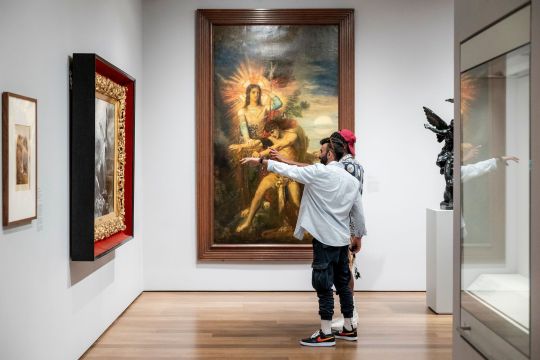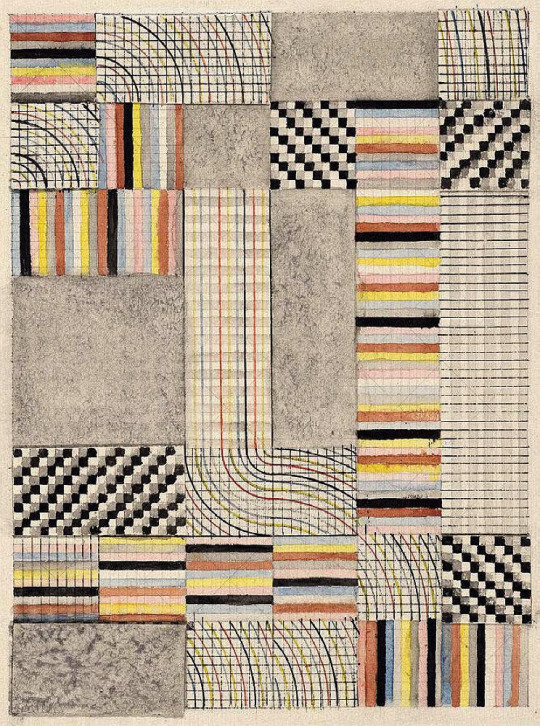#Busch-Reisinger Museum
Text

Birch Tree in a Landscape, Paula Modersohn-Becker, 1899
#art#art history#Paula Modersohn-Becker#female artists#landscape#landscape painting#trees#birches#Expressionism#Expressionist art#German Expressionism#German art#19th century art#oil on board#Harvard Art Museums#Busch-Reisinger Museum
102 notes
·
View notes
Text

Fetzentödlein, Death in tatters, South German, ca 1670. Boxwood.
Provenance: Germany, Rudolf Theodor Edler von Jaschke Collection (1881–1963).
Representations of skeletal figures were not rare in the Late Middle Ages: personifications of Death as the Grim Reaper with a scythe as his attribute or as an archer in the Dance of Death contexts appeared increasingly from the fifteenth century in frescoes, paintings and reliefs in churches. As a small piece of sculpture of a domestic character, on the other hand, the Fetzentödlein (literally ‘Small Death in tatters’) does not surface until the sixteenth century. The motif is Death depicted fully in the round in a small format as a skeletal figure from which scraps of decayed skin are dangling.
The earliest known work of this kind is a statuette carved before 1519, which is now in the Kunstkammer at Ambras Castle in Innsbruck and is attributed to the Landshut sculptor Hans Leinberger. The type of skeletal figure wearing its decaying skin like a tattered garment would undergo a sharp upturn in popularity in the latter half of the seventeenth century: several statuettes of this kind are kept by public and private collections, including the Bayerisches Nationalmuseum in Munich, the Victoria and Albert Museum in London, the Walters Art Museum in Baltimore, and the Busch-Reisinger Museum, which is part of the Harvard University Art Museum in Cambridge, Massachusetts. This small group of works is stylistically and structurally homogeneous, and dated to ca 1670 because the work in the Bayerisches Nationalmuseum bears the date numerals 1673 on its plinth. A pronounced delight in morbid details is flaunted in this small statue: decaying skin detaches itself from the cranial bones like a hood and encases the figure’s feet like decrepit old shoes; the abdominal wall gapes open to reveal the entrails, some of which bulge out and are crawling with vermin. The deliberately gruesome mode of representation contrasts with the virtuosity of execution that marks this boxwood statuette as an exquisite work of art.
Courtesy Alain Truong
21 notes
·
View notes
Text

Reclining Woman, Ernst Ludwig Kirchner, 1909, Harvard Art Museums/Busch-Reisinger Museum, Gift of Mrs. Margarete Schultz, 49.4 x 59.3 cm (19 7/16 x 23 3/8 in.) Lithograph printed in black ink on off-white wove paper.
21 notes
·
View notes
Text

Lena Bergner. Weaving Technique: B (Yarn Cone), 1943. Ink on paper. © President and Fellows of Harvard College/Harvard Art Museums/Busch-Reisinger Museum, Gift of Markus Michalke in honor of Timotheus R. Pohl.
10 notes
·
View notes
Text
Harvard Art Museums embrace free admission
Starting today (23 June), Harvard Art Museums is offering free admission for all visitors, joining the many university-affiliated museums in the US that have long provided such open access. The university’s Cambridge, Massachusetts, campus is home to the Fogg, Busch-Reisinger and Arthur M. Sackler museums, which together hold more than 255,000 objects from around the world dating from antiquity…

View On WordPress
0 notes
Video
vimeo
Moholy-Nagy's Light Prop, displayed @ SBMA from Santa Barbara Museum of Art on Vimeo.
MORE ABOUT US:
Our site: sbma.net
Twitter: twitter.com/sbmuseart
Instagram: instagram.com/sbmuseart
Facebook: facebook.com/sbmuseart
Our Blog: blog.sbma.net
------------------------------------------------------------------------------------------------------
Video ©Bryan Toro Photographic for the exhibition, The Paintings of Moholy-Nagy: The Shape of Things to Come, organized by the Santa Barbara Museum of Art, July 5 – September 27, 2015
László Moholy-Nagy
Light Prop for an Electric Stage, 1929-30, exhibition replica, constructed in 2006 through the courtesy of Hattula Moholy-Nagy
Metal, plastics, glass, paint, and wood, with electric motor
59 7/16 x 27 9/16 x 27 9/16 in.(151 x 70 x 70 cm)
Harvard Art Museums/Busch-Reisinger Museum, Hildegard von Gontard Bequest Fund, 2007.105
1 note
·
View note
Photo

Anni Albers, Design for a Rug, 1927
150 notes
·
View notes
Photo

Anni Albers, Design for a Rug, 1927
Black ink and watercolor over graphite with drawn and cut paper additions on off-white wove paper. Harvard Art Museums/Busch-Reisinger Museum, Gift of Anni Albers. © The Josef and Anni Albers Foundation/Artists Rights Society (ARS), New York. Photo: Harvard Art Museums; © President and Fellows of Harvard College
446 notes
·
View notes
Text

Hercules Strangling the Nemean Lion, Peter Paul Rubens, ca. 1639
#art#art history#Rubens#Peter Paul Rubens#classical mythology#mythological painting#Hercules#Heracles#Herakles#Labors of Hercules#Nemean Lion#Baroque#Baroque art#Flemish Baroque#Flemish art#17th century art#Harvard Art Museums#Busch-Reisinger Museum#animal violence tw
155 notes
·
View notes
Text

Gunta Stölzl, Tapestry, (cotton, wool, and linen fibers), 1922-1923 [Harvard Art Museums/Busch-Reisinger Museum, Cambridge, MA. © ARS, New York / VG Bild-Kunst, Bonn]
Digital Exhibition: Artisanal Modernism and the Labor of Women (Professor Maria Gough, Spring 2022), Harvard University, Cambridge, MA, Spring 2022
#textile#design#art#school#exhibition#gunta stölzl#maria gough#harvard art museums#busch reisinger museum#1920s#2020s
101 notes
·
View notes
Photo

Levy Residence, Chelsea, London, 1935-1936: View, garden side, Unidentified Artist, c. 1935-1936, Harvard Art Museums: Photographs
Harvard Art Museums/Busch-Reisinger Museum, Gift of Walter Gropius
Size: sheet: 15.8 x 20.3 cm (6 1/4 x 8 in.)
https://www.harvardartmuseums.org/collections/object/165360
243 notes
·
View notes
Photo

N H D (provinceenhaitchde), Paul Klee, 1932, Harvard Art Museums: Drawings
Harvard Art Museums/Busch-Reisinger Museum, Bequest of Virginia H. Deknatel in memory of Frederick Brockway Deknatel © Artists Rights Society (ARS), New York / VG Bild-Kunst, Bonn
Size: sheet: 50.6 x 35.7 cm (19 15/16 x 14 1/16 in.) mount: 64.9 x 45 cm (25 9/16 x 17 11/16 in.)
Medium: Watercolour on paper, mounted on card
https://www.harvardartmuseums.org/collections/object/330764
165 notes
·
View notes
Photo

Dancing in a Circle, Rudolf Franz Hartogh, c. 1920, Harvard Art Museums: Prints
Harvard Art Museums/Busch-Reisinger Museum, Gift of European Friends of the Busch-Reisinger Museum
Size: 31.5 x 40.5 cm (12 3/8 x 15 15/16 in.)
https://www.harvardartmuseums.org/collections/object/221326
170 notes
·
View notes
Photo

Standing Girl, Lovis Corinth, 1896, Harvard Art Museums: Prints
Harvard Art Museums/Busch-Reisinger Museum, Gift of Erich Cohn
Size: plate: 15.2 x 6.6 cm (6 x 2 5/8 in.) sheet: 28.9 x 23.2 cm (11 3/8 x 9 1/8 in.)
Medium: Etching printed in black ink on cream wove paper
https://www.harvardartmuseums.org/collections/object/223785
88 notes
·
View notes
Photo

Untitled student exercise from Newcomb College, Unidentified Artist, 1942-1949, HAM: Sculpture
Harvard Art Museums/Busch-Reisinger Museum, Gift of Professor R.D. Feild
Size: 20.32 cm (8 in.)
Medium: Construction of wood with string
https://www.harvardartmuseums.org/collections/object/225385
348 notes
·
View notes
Video
vimeo
László Moholy-Nagy’s “Light Prop for an Electric Stage (Light-Space Modulator)” in Motion from Harvard Art Museums on Vimeo.
One of the earliest electrically powered kinetic sculptures, “Light Prop for an Electric Stage” (1930) holds a central place in the history of modern sculpture. Representing the culmination of László Moholy-Nagy’s experimentation at the Bauhaus, it incorporates his interest in technology, new materials, and, above all, light.
Moholy-Nagy sought to revolutionize human perception and thereby enable society to better apprehend the modern technological world. He presented “Light Prop” at a 1930 exhibition of German design as a mechanism for generating “special lighting and motion effects” on a stage. The rotating construction produces a startling array of visual effects when its moving and reflective surfaces interact with the beam of light. The sculpture became the subject of numerous photographs as well as Moholy’s abstract film “Lightplay: Black, White, Gray (1930).” Over the years the artist and later the museums made alterations to the sculpture to keep it in working order. It is still operational today.
TAKE A CLOSER LOOK:
+ László Moholy-Nagy, “Light Prop for an Electric Stage (Light-Space Modulator),” 1930, sculpture, Harvard Art Museums/Busch-Reisinger Museum, BR56.5, © Artists Rights Society (ARS), New York / VG Bild-Kunst, Bonn:
hvrd.art/o/299819
VIDEO—László Moholy-Nagy’s “Light Prop for an Electric Stage (Light-Space Modulator)” in Motion: vimeo.com/111474831
VIDEO—Student Guide John Wang on Moholy-Nagy: vimeo.com/165355142
--
© President and Fellows of Harvard College. Video: Danny Hoshino. For questions related to permission for commercial use of this video, please contact the Department of Digital Imaging and Visual Resources at [email protected].
Part of records transfer HUAM.RECORDS.2018.47. Contact the Archives at [email protected] for more information. ArchivesSpace reference ID comm20180807_031.
0 notes